By Jeffrey A. Rendall; Images Courtesy of About Golf
MAUMEE, OH – Mark Twain once said (paraphrasing), ‘Everybody gripes about the weather, but nobody ever does anything about it.’
Well, now we can honestly say, somebody’s doing something about it – at least when it comes to the game of golf. In our twenty-first century technological world, earthly limitations such as temperature and precipitation are being defeated at the hands of folks who’re fighting to bring the game into more climate controlled environments, courtesy of an invention that will certainly change every golfer’s life at some point. If you’ve been to a large golf retailer, you’ve probably seen one – it’s a golf simulator.
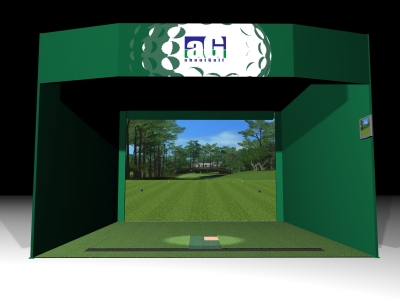 |
Simulators are just that – machines designed to replicate every aspect of golf, so that you can practice or play whenever the desire hits, or time permits. It’s a part of golf that’s growing rapidly and gaining more and more acceptance in a world of touchpad communications and electronic substitutes for just about everything imaginable.
Why should golf be any different?
Bill Bales is the Founder and CEO of About Golf, a leading producer of golf simulators, and he says that the concept of indoor golf will revolutionize – and improve – the game: “I’ve been to any number of meetings on the ‘state’ of the game of golf, and the biggest concern is how much time it consumes. We used to live our lives in six hour increments, and now it’s two – and people, because of changing lifestyles, don’t have time to keep golf relevant in our lives. It’s not that we don’t like the game, it’s just that we don’t have the time for it.”
More than anything else, you hear folks in the golf industry talk about concepts like pace-of-play as the primary reason why the total numbers of golfers playing the game remains relatively stagnant – meaning just as many people are quitting the sport as those taking it up. It’s led to efforts on behalf of golf course owners to maximize the time element – course marshals, on-course beverage and food service, longer increments between tee times, or flashing ‘keep up or else’ messages relayed through a cart’s GPS monitor.
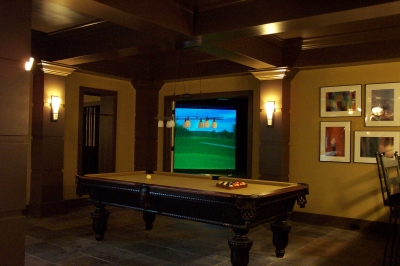 |
| Your basement of the future -- a home theater, recreation room, and a golf simulator. |
No one likes to hurry when playing, yet no one wants to spend five and a half hours on a golf course, either. Bales is right – devoting nearly half of your waking hours (including travel time, warm-up and the nineteenth hole) to golf in any given day is a difficult prospect in our busy lives.
In addition to time it takes, there are other issues involved with golf’s malaise, such as frustration, expense and even intimidation, especially for new players. For those of us who’ve played golf since we were very young, we tend to forget how scary it used to be to go to a golf course when you’re just learning, and having to overcome all those judgmental staring eyes on the first tee.
Simulators address all of these concerns, by allowing us to play golf in much less time than would be the case on course, while also permitting those incubating players a chance to grow a little in the ways of the game without being told to ‘hurry up’ or ‘get out of the way.’ This is especially important in encouraging more women to try what in many circles is viewed to be a man’s game, and eliminates one more barrier for juniors as well.
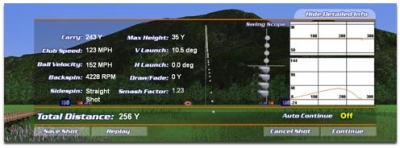 |
| An About Golf simulator will give you accurate readings of your swing's 'vital signs.' |
Bales’ love of golf is evident in his philosophical approach to it, but is also present in his decades-long devotion to developing his company and the concept of golf simulation in general. A self-labeled ‘crusader’ for ‘Indoor Golf,’ Bales first began working in golf software in 1988, primarily with computer golf games, and then in the late 90’s with a concept he calls ‘Adver-gaming.’
He was introduced to simulators in late 2001, immediately realized the need to get into the development side of them, and formed About Golf in early 2002. Since that time, About Golf has been the fastest-growing golf simulator producer in the world.
The company’s rapid ascent is no accident, as Bales was able to call on his lengthy experience in the golf software development industry, as well as compile a team to perfect (or at least come close to) a device to accurately track and predict the flight course of a golf ball under all types of situations.
Even so, golf’s a hard game to play indoors, and make it ‘feel’ like you’re still taking part in a real round. Simulating the game means getting as close as possible to what you see and hear on a golf course… or at a practice range.
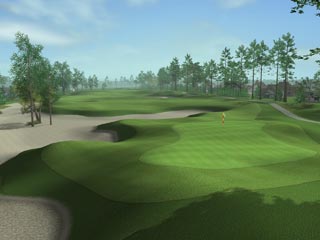 |
| About Golf's graphics are attractive, and current. |
Bales says there’re two elements that comprise the ideal golf simulator – ‘golf experience,’ and practice. “As far as playing a round of golf, the more you can make it like the real thing, the better. It all leads to a suspension of disbelief – that really, in the player’s minds-eye, they feel like they’re playing Pebble Beach or whatever course they’re experiencing at the time.”
In order to ‘suspend belief,’ you need to be able to simulate every type of shot there is in golf. Bales says it’s one thing to replicate a tee shot or a full seven-iron, and quite another to try and simulate a duck-hook, or certain types of chips – or perhaps most importantly, putting.
Remarkably (we saw a demonstration), the About Golf simulator does all of the above – including things such as bunker shots or from deep rough. Just don’t ground your club in the ‘hazard!’
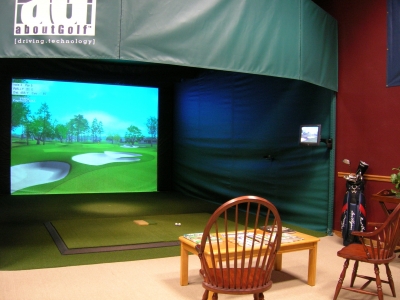 |
Then there are the intangibles – the ‘experience’ you get from playing golf. “That’s where I think our game development experience has been beneficial,” Bales explained. “I believe we understand the game of golf as well as anybody in the industry, doing any kind of technology for tracking a golf ball.”
The practice element requires a more pragmatic approach. Again, Bales supplies the answers: “On the game improvement side, which would encompass practice and self-analysis and teaching, you need to create an environment suitable for teaching and club-fitting. Because of the tracking technology that we’ve developed for the product, we’ve definitely, in my opinion, taken simulators to a new level – as far as their ability to aid in teaching, club-fitting and practice.”
It works so well that the Director of Teaching and Club-fitting for PGA Tour Superstores stated there’s no better place in the world to teach or fit clubs than in an About Golf simulator. The combination of visual feedback – being able to watch an extremely accurate ball flight – and using the additional tools such as video or other instructional aids makes the simulators so effective.
One place in the simulator world where there’s still much work to be done is the price. Because of the developmental costs of the software and the high-tech requirements of the hardware, an About Golf simulator isn’t likely to show up under your Christmas tree anytime soon. And even if it was, you’d need a heck of a lot of space to effectively utilize it.
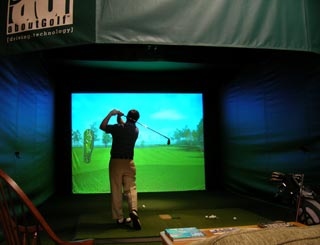 |
Whereas media rooms are becoming as common as cook-top stoves in new houses, to have your own personal golf simulator requires a lotta dough and a big room to put it in. And while you can expect to see them become more common, it’ll be a slower growth process.
“With media rooms, you can easily spend a million dollars, but you can also spend $500,” Bales explained. “And you can create a full size theater in a very small room. Golf simulators are definitely more limited, because there’s a certain footprint for a golf swing just by itself, let alone any limitations the system might impose relative to how far the ball has to fly, etc…”
Currently, Bales said 15-20% of sales are to private buyers, primarily for use in homes – which carries with it a minimum $40,000 investment. There’s also the spatial needs, which should be at least 450 square feet, to do it right.
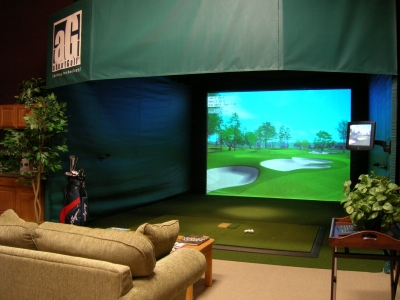 |
That’s not to mention the ten foot high ceilings. Not too many basements out there with that kind of depth.
In other words, the current market for simulators is almost entirely made up of retailers or so-called ‘Indoor Golf’ centers. Retailers use them as an attraction for trying clubs, club-fitting and sometimes for teaching. The ‘Indoor Golf’ centers put in as many as ten systems in one location for people to come and play golf, just as they would get together with their regular foursome at the club.
Not surprisingly, cold weather climates lead the way in pioneering these indoor places to play. Bales says Canadians are nuts about golf – about one in every four Canadians play golf as opposed to one in ten Americans – so they’ve adopted the concept of playing indoors fairly quickly. There are also the Asian markets – in Korea and Japan especially – where the demand for tee times greatly exceeds the supply, and people in these countries could very well learn to be good players, almost entirely experiencing the game with a roof over their heads.
One of the company’s goals is to try and bring the pricing down so more people would consider building these systems in their homes. “We have a desire to create products at different price points going down the scale,” Bales added. “And also, to design systems that can be used in the smallest possible footprint – so that the guy who would otherwise buy one or two jet skis or snow mobiles, or take a Disney vacation could instead buy a golf simulator for his house.”
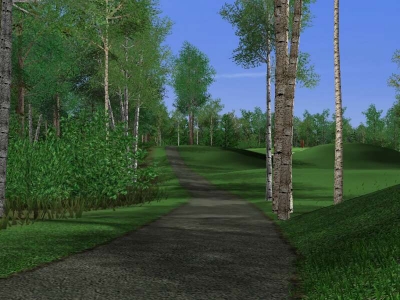 |
| Those aren't real trees, but if you 'hit' one of them, the ball will bounce off it like they're plenty solid. |
In order to make it affordable, there’s still a ways to go (at the lower prices) in providing the graphics and ‘intangibles’ that will keep people interested – even after a period of time.
I mentioned to Bales that I’d been hooked up to fitting systems at a couple of the major equipment manufacturers, and he said those really aren’t simulators in the same sense, but really more like ‘launch monitors’ that gather very precise data about the way you strike the golf ball and how the ball flies once it leaves the club. Such systems are far more precise in measurements – and far too expensive – to be available on a mass scale.
Some of the systems also measure your body in three dimensions, which isn’t really required for a good simulated game of golf.
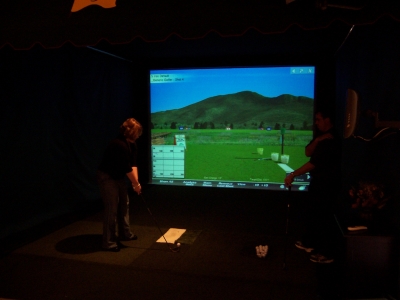 |
| 'Indoor Golf' provides the perfect environment for no-pressure teaching and learning. |
They also require a tremendous amount of calibration to keep them functioning properly, which is one huge advantage to using an About Golf system. Bales says if it’s initially set up properly, there will be virtually no down time in the simulator. Busy retailers and Indoor Golf centers particularly enjoy that benefit, since they’re able to keep things going, while not having to devote staff to the task of calibrating them.
As a final note, though Bales says the concept of ‘indoor golf’ and simulators will change the way we think about golf, ‘real’ green grass golf courses needn’t worry. ‘Indoor Golf’ will only help grow the game.
“There’s no reason, culturally, that we couldn’t create a subset of golfers that spend a lot of time indoors,” Bales hypothesized. “Golf course owners should be our biggest supporters, because we’ve found – of people who do play Indoor Golf, there are two classes.”
“The biggest class is just avid golfers – the first ones to hit the course when they get a chance. It just makes them love it more, and be ready and more anxious to hit the course when it’s open. Then you have the beginners that you wouldn’t keep at the course or who might never get there in the first place – and we can bring them to the point where they can’t wait to get out there and give it a try,” Bales said.
In other words, indoor play compliments, rather than replaces, what you get outside. Now you can say, if you’ve found an About Golf simulator, that you’re seeing the downside of the weather – and finally doing something about it.
Details:
AboutGolf Limited
Phone: 419-868-6091, ext 46
Fax: 419-868-8084
Email: sales@aboutgolf.com
Note: Contact the company for the location of the nearest AboutGolf simulator. The one we saw was in a private home.
| Related Links | Comments on this article? | |
|
Maryland National Golf Club Hollow Creek Golf Club Rocky Gap Resort PB Dye Golf Club in Ijamsville Whiskey Creek Golf Club |
E-mail Jeff Rendall, Editor: jrendall@golftheunitedstates.com |












